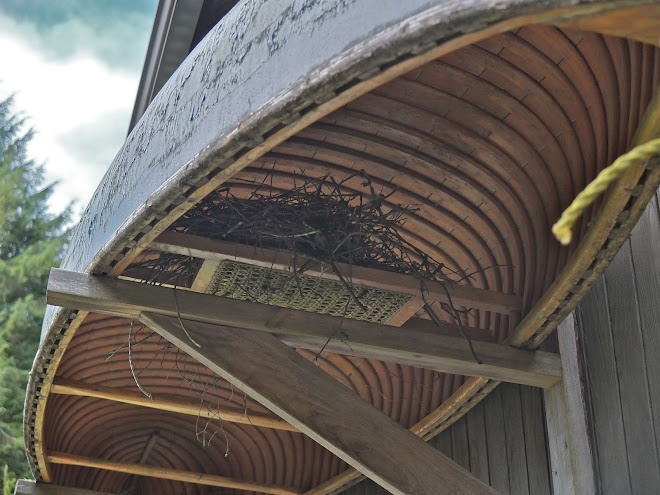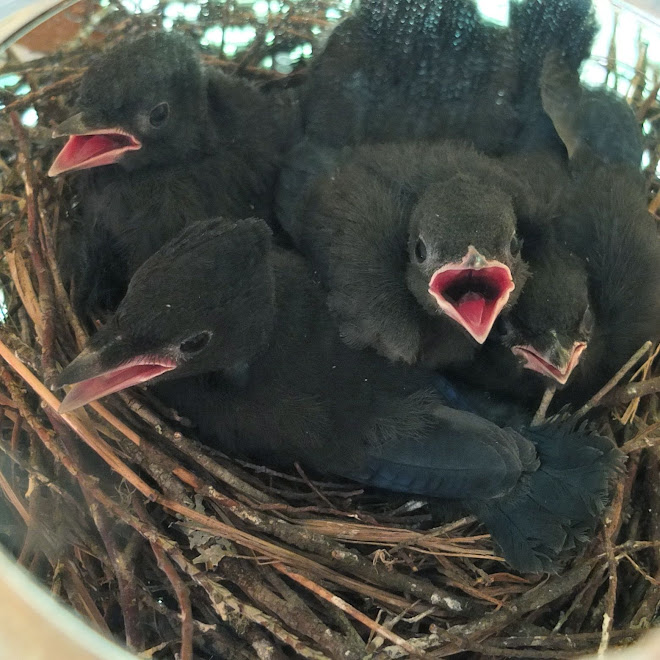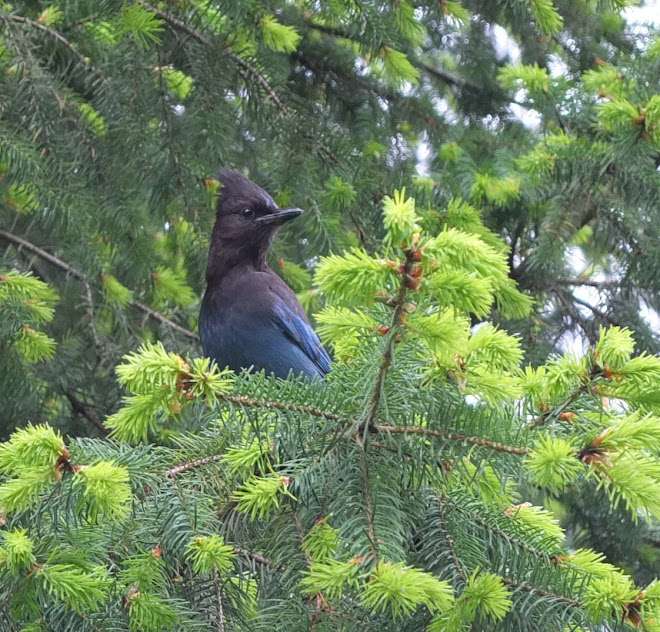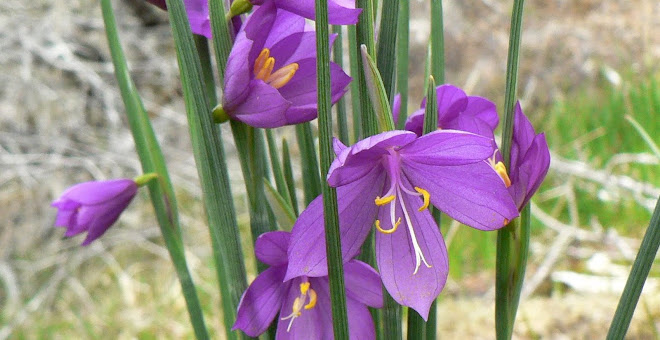Quote from Reverend Henry Ward Beecher's admiring words, “If men had wings and bore black feathers, few of them would be clever enough to be crows”
In mid-March, Rob Butler, a pre-eminent BC birder and bird researcher, gave a “Talk” on our local crows to a packed and appreciative audience, the forty-eighth presentation of the Talk and Walk series. Rob’s passion and love for his subject was equaled by the enthusiasm of the attendees.
Wise Guys
Calling them “Wise Guys”, Rob explained that our crows are a species known as Northwestern Crow (Corvus caurinus), occurring from Alaska through BC and into northwestern Washington State. They decrease in abundance with increasing distance from the coast and increase in elevation. Most birds nest within a few kilometers of the sea. Members of the Corvid family, which includes ravens and jays; they are clever, superior in intelligence to most other birds and rival the brainpower of many non-human primates. One anecdote showed them to be smarter than his graduate students! The research involved hiding food in a large container filled with kitty litter. The crows were able to accurately remember the exact location of the food almost every time, but the graduate students were dismal failures at the task.
The crows ability to learn from observation is culturally transmitted to other crows. Crows can often be seen dropping shellfish onto hard surfaces, in order to crack them open. In Japan, a few very observant crows figured out that if they dropped a nut onto a busy street, a car would run over it and make the nut cracking a sure thing. They even learned to use the street lights. Waiting until the light turns red, they walk out and carefully place the nut where the tires will run over them, then they fly back, watch the nuts get cracked as the light turns green; when it goes back to red, they calmly walk out and retrieve their cracked nuts…This mode of nut cracking has been slowly making it’s way out into the wider crow population, as crows learn the successful behaviour from observing other crows.
Bird researchers build blinds, in order to study birds nesting. They slowly inch the blind closer to their subjects, until they can study them, unnoticed, as close as possible, which works well for most birds. However, it appears that crows can count and if they see two or three people going into a blind, they will patiently outwait the researchers, not coming close enough to be studied until the number of researchers who went into the blind equals the number who have left. Crows will even go peak into the vents to make sure they have all decamped.
Crows routinely construct tools, they will remove a leaf from a tree, rip the petiole until they have the shape they want and use the resultant hook to remove grubs from crevices in trees. In laboratories, crows have used wires to perform the same feat, being able to access previously inaccessible food sources. The will even wrap the wire around an object until it forms a hook.
Co-Evolution
Rob went on to explain that crows and humans may have co-evolved. The argument for this is a bit convoluted…this is how the theory goes:
Early humans on the African savannah were most likely scavengers;
Wolf pack size dictates how much is eaten by each wolf, the optimum size and best per capita return is nine;
Nine wolves are better at keeping away scavengers (crows) and do better than a lone wolf;
Early humans would scavenge large carcasses;
Those with the brain capacity to cooperate succeed in keeping other scavengers away like the wolf pack);
Brain capacity improves in response to success in cooperation;
Cooperative groups become hunters of large prey;
Large prey supports larger groups;
Therefore crows helped human brains develop and humans provide more food for scavenging crows = co-evolution
There is evidence that early First Nations and crows had a natural co-evolution in which First Nation people dried salmon, the crows would try to steal the salmon. Keeping the salmon safe from the crows required a lot of teamwork, teamwork requires social skills, and social skills define humans.
Likewise the crows have developed social skills that allow them to work in groups to secure food.
Culture of thievery, food caching and communal harvesting
Rob conducted research on crows at Mitlenatch Island, which supports a large seabird colony on 35 ha. There are two distinct groups of crows, ones who nest by the beach and others who nest on the hills and in the forests. Crows are quite territorial around their nest site and territories are vigourously defended. All adult crows spend most of their time feeding on the beach, three quarters of the day is spent supplying food to the young. Hill crows must fly further and expend more energy to feed their family. Beach crows spend less time flying, expend less energy and can therefore successfully raise more juveniles. Harvesting food requires many skills. It has been shown that crows carefully judge the optimum size of clam to forage. Small clams are not worth the effort it takes to find them, dig them up, fly with them, drop them onto rocks and harvest the meat. Middle sized clams are preferred. Large clams are harvested and cached for later. Even dropping the clams is a science. Drop from too high and the clams are likely to be stolen before the bird can swoop back down to them, from too low and they don’t crack, at just the right height, they crack and there is not enough time for the meat to be stolen. However, if smaller clams are offered, and the crows don’t have to expend the energy to find and dig them, they will use them. All this ability to make judgments and calculations takes practice and the young crows are not good at judging sizes or the heights to drop them from. These are skills the learn.
Cooperation
Some crow parents, particularly the crows in the prime beach location, receive assistance from a yearling son, who returns to help raise the new family. Females lay an average of three to four eggs in mid-April, the eggs decrease in size and become paler as the clutch is laid over several days. Considering the amount of egg stealing, it makes sense that a pale egg is more likely to be noticed and snatched; preserving the larger and more fully developed embryo. The adult sibling, identified by a brownish cast to its feathers, helps defend the territory in exchange for food. Families with a helper were more successful in raising their young. Even though crows will steal from each other, raid nests and generally behave in ways we might find upsetting, they will cooperate if a predator arrives. They will mercilessly mob hawks, ravens, eagles and owls, calling loudly and dive-bombing the intruder.
As an interesting aside, ravens have been observed leading wolf packs to a distressed animal. After the kill, they are able to scavenge the remains.
A lot of these stories involve food and survival but crows also play, there are many videos on youtube showing crows swinging upside down from willow branches, playing with objects, teasing cats, surfing on a snow covered roof on it’s own snowboard (http://www.youtube.com/watch?v=L7cuKYLrJgc&feature=fvwrel)
They like a good time as much as the rest of us…which strikes a chord, perhaps we see ourselves in their antics and drive to survive.
Roosting
As the young fledge and leave their nests, crows become more social and communally minded. They can form vast flocks that congregate in an area to roost during the night. One area in Burnaby is estimated to have 15,000 crows roosting together, some flying for forty-five to sixty minutes to reach the roost. They are very loud and boisterous and appear to prefer areas that are well lighted. It’s thought that this urban congregation is in response to the predation by great horned owls in rural landscapes. Hence many crows travel to urban roosts, where there are less owls.
From earliest days, crows and ravens have been an important component of First Nations’ mythology, being labeled the “trickster”, a mischievous creature. Their intelligence, playfulness and resourcefulness have spawned many stories and anecdotes and endeared them to many.
(Poem by me, a la Ogden Nash/Bill Richardson)
Within the family, they use their skills,
To feed their young, their beaks they fills,
with crabs and fish
and things delish…
But away from home they use their brains,
To play some tricks and cause some pains…
From crows nearby they steal the eggs,
Even though they pleads and begs.
But in the fall, they roost together,
No matter how inclement the weather,
To thwart the owls, they will make peace,
Though the neighbours wish they’d cease.
Too smart by half, a murder of crows,
In the vicinity, a long way goes..








